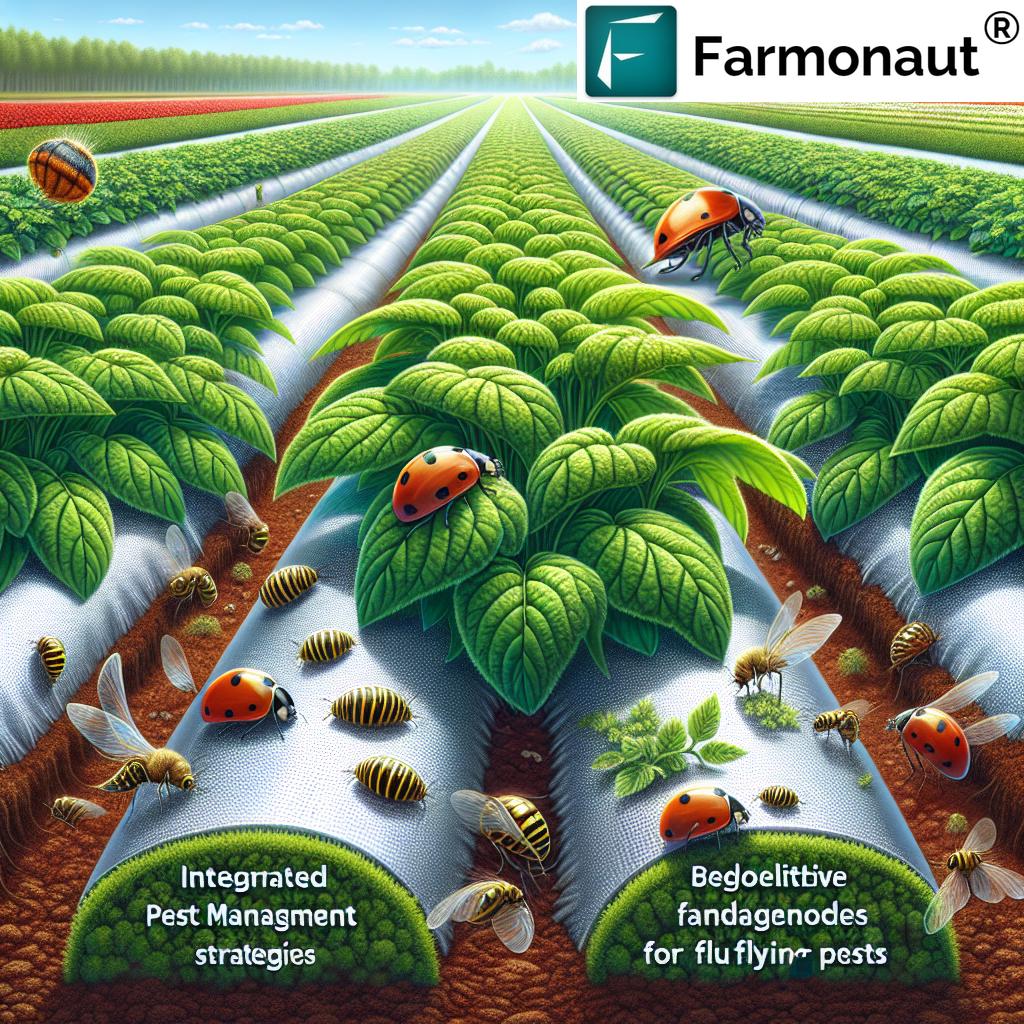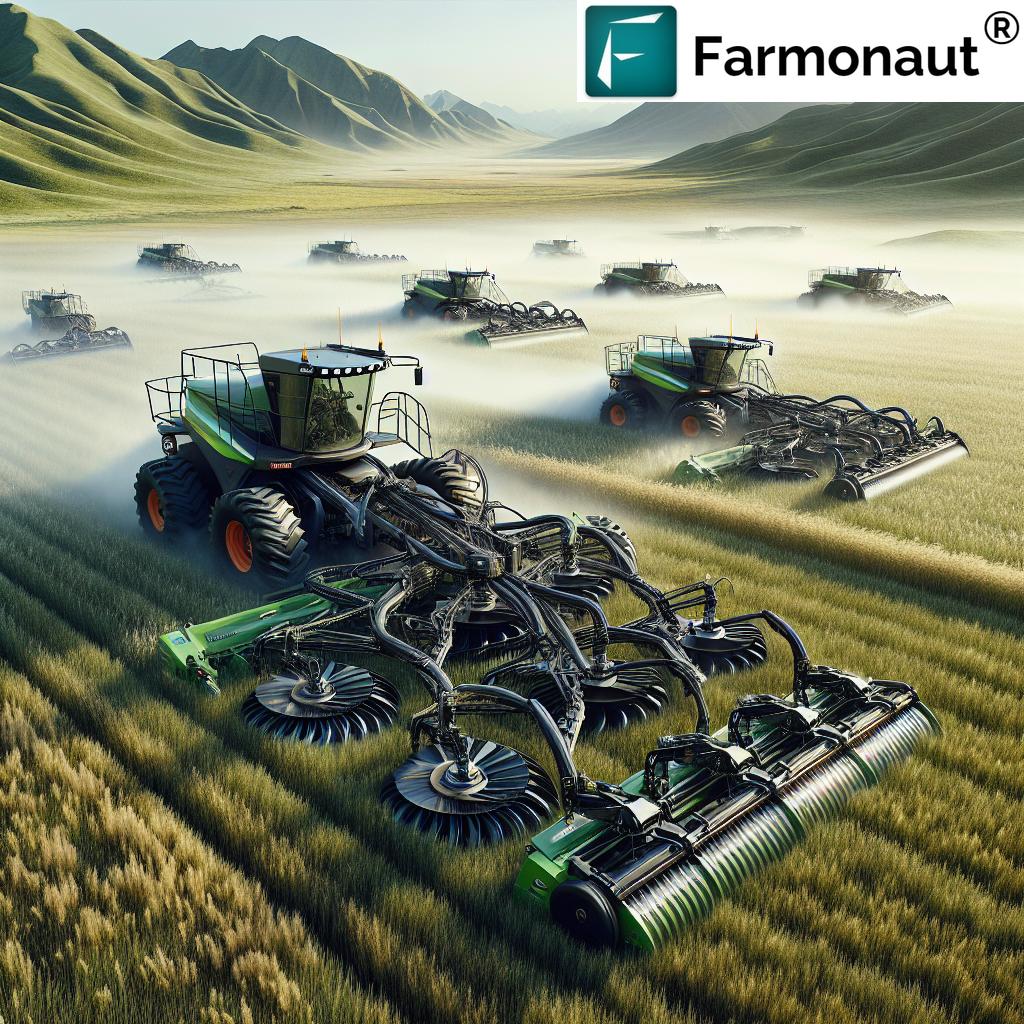Thrips vs Aphids: Shocking Pest Hacks Revealed!
“Did you know? Thrips can reduce crop yields by up to 50% if not managed with integrated pest solutions.”
Table of Contents
- Introduction: The Threats of Thrips and Aphids in Agriculture
- Biology and Identification: How to Identify Thrips and Aphids
- Impact of Thrips and Aphids on Crop Yield and Plant Health
- Comparison Table: Thrips vs Aphids
- Management Strategies for Thrips and Aphids
- Integrated Pest Management for Thrips and Aphids (IPM)
- How Farmonaut Empowers Crop Pest Management
- FAQ: Thrips and Aphid Management Strategies
- Conclusion: Sustainable Pest Management in Modern Agriculture
- Farmonaut Subscription Plans
Introduction: The Threats of Thrips and Aphids in Agriculture
As we navigate the ever-evolving landscape of modern agriculture, we are consistently challenged by the persistent presence of crop pests. Among the most prevalent and destructive insects are thrips and aphids. These tiny organisms have the power to cause a profound impact on crop productivity, plant health, and the overall sustainability of our food systems. The threat is twofold: they not only cause direct damage to leaves, flowers, and fruits, but also act as potent vectors for deadly plant viruses.
An informative and problem-solving approach is essential to tackle these threats. Our mission in this article is to provide a comprehensive understanding of their biology, their impact on agriculture and forestry, and reveal shocking, science-driven pest management strategies—ranging from cultural to chemical to biological solutions. We will discuss the importance of integrated pest management for thrips and aphids and illustrate how leveraging data-driven platforms like Farmonaut can take pest risk monitoring to the next level.
By the end of this guide, you’ll understand how to identify thrips and aphids, prevent severe infestations, and implement effective control methods, maintaining both crop yield and plant health.
Biology and Identification: How to Identify Thrips and Aphids
Accurate identification is the cornerstone to any effective pest management strategy. Let’s explore the key characteristics that set these tiny pests apart.
Thrips: Tiny Vectors with Fringed Wings
- Measuring Length: 1–2 mm — so small, they can be hard to spot without magnification.
- Physical Appearance: Slender bodies, characterized by distinctive fringed wings.
- Mouthpart: Rasping-sucking—they puncture plant cells and extract their contents.
- Feeding Damage: Visible as stippling, silvering, and distortion of leaves and flowers.
- Role as Vectors: Thrips can transmit tospoviruses and other viruses, heightening the disease threat.
Resource: Understanding Thrips Biology [pubs.ext.vt.edu]
Aphids: Prolific, Soft-Bodied Sap Extractors
- Measuring Length: 1–10 mm.
- Physical Appearance: Small, soft-bodied pests—typically green, but can also be black or red.
- Pear-shaped bodies with long antennae and two tailpipe-like structures called cornicles.
- Mouthpart: Needle-like mouthparts—inserting mouthparts into plant tissues to extract sap.
- Feeding Damage: Stunted growth, curled and distorted leaves, and transmission of mosaic viruses.
Resource: Aphid Biology and Control [Krushagra]
“Aphids reproduce rapidly—one female can produce up to 80 offspring in a week, making early control essential.”
Our ability to identify thrips and aphids early is critical to preventing severe outbreaks. Their discrete behavior and tiny size demand vigilance and regular scouting of crops.
Impact of Thrips and Aphids on Crop Yield and Plant Health
The impact of thrips and aphids on crop yield is both direct and indirect, affecting plant growth, leaves, and overall health. Here’s how they disrupt our agricultural and forestry landscapes:
- Feeding Damage: Both pests puncture plant cells to extract sap or cell contents, causing stippling, silvering, deformation of leaves and flowers, and curled or stunted growth.
- Nutrient Loss: By draining nutrients and reducing photosynthesis, these insects weaken plants and compromise fruit quality.
- Transmission of Diseases: Their role as vectors of viruses exacerbates the problem. Diseases such as tospoviruses (thrips) and mosaic viruses (aphids) can quickly spread throughout crop populations, causing severe losses.
- Estimated Yield Loss: Severe infestations can reduce crop yields by 30–50%, depending on crop type and severity (LeasedAdSpace).
- Economic Impact: Inferior crop quality and reduced yield decrease farmer income, exacerbate food security challenges, and prompt increased use of chemical treatments—a major sustainability concern.
- Biodiversity and Ecosystem Disruption: Excessive insecticide use to control pest populations can also harm beneficial insects and disrupt agricultural ecosystems.
Understanding this impact underpins the importance of adopting integrated and sustainable pest management approaches, which we will explain in detail ahead.
Comparison Table: Thrips vs Aphids—Impact, Control, and Management Strategies
| Aspect | Thrips | Aphids |
|---|---|---|
| Physical Appearance | Tiny & slender (1–2 mm), fringed wings, piercing–sucking mouthpart | Small, soft-bodied (1–10 mm), green/black/red, pear-shaped with cornicles |
| Common Crop Damage | Stippling, silvering, distortion of leaves & flowers; vector for tospoviruses | Stunted, curled leaves; sticky honeydew; vector for mosaic viruses |
| Estimated Yield Loss (%) | 10–20% (up to 50% in severe outbreaks) | 15–30% (up to 50% in severe infestations) |
| Peak Infestation Season | Spring & early summer; hot, dry conditions favor build-up | Spring & autumn; humid, mild weather promotes rapid reproduction |
| Preferred Control Methods | Reflective mulch, predatory mites, entomopathogenic fungi, spinosad insecticide | Sanitation, ladybugs, neem biopesticides, insecticidal soaps |
| Biological Control Availability | High—predatory mites, fungi | Very High—ladybugs, lacewings, parasitoid wasps |
| Estimated Cost of Control (per ha) | $25–$100 (varies by crop & approach) | $20–$80 (varies by severity & chemical/biological use) |
| Integrated Pest Management Adaptability | Excellent—responds well to monitoring, threshold-based controls | Excellent—scouting and early intervention most effective |
Management Strategies for Thrips and Aphids
Managing thrips and aphid pests requires a multipronged approach. We recommend combining various control methods: cultural techniques to create unfavorable conditions, biological controls to leverage natural enemies, and selective chemical tools when absolutely necessary. This is the foundation of integrated pest management for thrips and aphids.
Cultural Control: Reflective Mulch & Sanitation
- Reflective Mulch for Pest Control:
Utilizing silver or gray plastic films (reflective mulch) redirects light, which strongly deters flying insects like thrips and aphids from locating plants.- This technique is particularly effective in preventing virus transmission by crop pests in susceptible crops.
- Sanitation:
Regularly removing plant debris and weeds around your crop reduces habitats and breeding sites for these pests, cutting off their life cycle.
Biological Control of Crop Pests
Harnessing natural enemies is one of the most effective, sustainable ways to manage thrips and aphid populations.
- Predatory Insects:
- Ladybugs (lady beetles) voraciously consume aphid colonies.
- Predatory mites (especially Amblyseius cucumeris) are deployed against thrips.
- Details on Predatory Insects
- Entomopathogenic Fungi:
- Beauveria bassiana and other fungi infect and kill both aphids and thrips upon contact. They can be safely applied as biopesticides with minimal environmental risk.
- Read More on Biopesticides for Thrips and Aphids
Implementing these biological control of crop pests strategies helps restore natural crop ecosystem balance, protects beneficial organisms, and supports long-term pest suppression.
Chemical Control of Thrips and Aphids
While natural and biological solutions are preferred, sometimes severe infestations necessitate the use of chemical interventions. Our approach favors rotating chemical classes and prioritizing biopesticides to avoid resistance development and protect environmental health.
- Insecticides:
- Products like spinosad are effective against thrips, while pyriproxyfen or imidacloprid may be used for aphids.
- Avoid overuse—integrate with monitoring and threshold-based application whenever possible.
- Chemical Insecticide Details by IFAS
- Biopesticides:
- Neem oil and pyrethrin offer targeted control with low risk of environmental harm and minimal toxicity to humans or beneficial insects.
- Excellent for organic growing systems; can be repeated as needed for persistent infestations.
- Read More About Natural Ways to Control Aphids and Thrips
Integrated Pest Management for Thrips and Aphids (IPM)
Integrated pest management for thrips and aphids (IPM) brings together all the above strategies—monitoring, cultural, biological, chemical—for a holistic, sustainable pest control system. We strongly encourage farmers to:
- Monitor fields regularly using visual scouting, sticky traps, or, for scalable operations, digital remote sensing tools provided by platforms like Farmonaut.
- Identify economic thresholds—intervene only when pest populations threaten crop health or yield.
- Apply strategies in combination for best results and resistance management.
- Preserve beneficial insects and natural predators by avoiding unnecessary broad-spectrum insecticide use.
- Educate field staff and workers about signs of early infestation and best practices in crop hygiene.
Related: Visit Farmonaut Carbon Footprinting to learn how efficient pest and resource management supports sustainable carbon goals.
IPM is especially effective when built atop real-time data and AI-derived advisories—a capability made possible by Farmonaut’s satellite-based crop health monitoring and Jeevn AI advisory system.
How Farmonaut Empowers Crop Pest Management
In our quest for effective thrips control in crops and robust aphid management strategies, Farmonaut stands out for its revolutionary data-driven approach. Below, we detail how our smart tools amplify your pest management game:
1. Satellite-Based Crop Health Monitoring
- Monitor vast crop fields remotely for early signs of pest infestation (such as patchy chlorosis, unusual canopy reflectance, or sudden yield dips).
- NDVI, soil moisture, and stress metrics guide when and where to target control methods, so resources are spent efficiently.
2. Jeevn AI Advisory System
- Farmonaut’s AI-driven advisory platform delivers customized, real-time pest and crop management actions using field and weather data.
3. Blockchain-Based Traceability
-
Secure, transparent product traceability helps prove adherence to best pest management practices, reassuring agribusiness buyers and consumers.
4. Carbon Footprinting and Fleet Management
- By
tracking carbon emissions and
optimizing operations, you achieve sustainable pest management at scale—minimizing chemical use and fuel waste.
5. Flexible Access and Scalability
- With farm and forest monitoring available via web app, Android, and iOS, everyone from smallholder farmers to agro-corporates can access powerful insights anywhere.
- Also available as an API (see docs) for integrating real-time pest and weather data into your own business tools.
6. Crop Loan & Insurance Verification
-
Satellite data enables
faster, more accurate crop loan and insurance verification, reducing risk for both farmers and lenders—especially important in pest-prone seasons.
Start making data-driven pest management decisions for sustainable yield and plant health improvement today!
FAQ: Thrips and Aphid Management Strategies
Q1: How can I differentiate between thrips and aphids in the field?
Answer: Thrips are tiny (1–2 mm), slender, with fringed wings, often moving quickly when disturbed. Aphids are small to mid-sized (1–10 mm), pear-shaped, soft-bodied, usually seen clustering together, and commonly green, black, or red. Look for thrips’ stippling and silvering on leaves and aphids’ curled, sticky, or deformed growth.
Q2: What is the best method for early detection of these pests?
Answer: Regular field scouting, sticky traps for flying insects, and digital crop health monitoring (Farmonaut’s satellite and AI insights)—which detect crop stress before visible symptoms.
Q3: Are chemical insecticides necessary for every infestation?
Answer: No. Use chemical control of thrips and aphids only for severe, economically significant outbreaks. Favor an integrated approach: combine biological and cultural methods for sustainable control and avoid resistance.
Q4: What are natural ways to control aphids?
Answer: Encourage predatory insects like ladybugs, use neem-based biopesticides, practice sanitation, and employ reflective mulches. These are effective, eco-friendly, and fit well in organic agriculture.
Q5: Does IPM really reduce yield loss?
Answer: Yes. Fields using integrated pest management for thrips and aphids generally reduce yield losses to low, predictable levels compared to single-method pesticide reliance, as IPM disrupts the pest life cycle and preserves beneficials.
Conclusion: Sustainable Pest Management in Modern Agriculture
Thrips and aphids are formidable threats—tiny yet devastating, with the capacity to diminish crop yield and long-term productivity. A comprehensive understanding of their biology, systematic monitoring, and the adoption of cultural, biological, and chemical strategies—all within an IPM framework—is the key to resilient agriculture.
Technological platforms like Farmonaut offer affordable, accessible, and highly effective analytics to guide pest control activities at every scale. As we continue to prioritize plant health—through reflective mulches, natural enemies, selective biopesticides, and real-time health assessment—we secure both the sustainability of our farmlands and the safety of our global food supply.
Let us collectively move toward science-based, eco-friendly, and digitally-enhanced crop protection for the future of farming.
Farmonaut Subscription Plans
Ready to unlock advanced pest and crop management insights? Choose a Farmonaut subscription that fits your need and get started with real-time monitoring, AI-based advisory, crop traceability, and more.
Farmonaut Carbon Footprinting
: Track and reduce the environmental impact of crop protection activities to optimize sustainability outcomes.
Farmonaut Fleet Management
: Manage logistics and monitor machinery to ensure efficient, safe farm operations while executing pest monitoring and control.
Farmonaut Product Traceability
: Provide buyers with crop origin and treatment data, supporting transparent supply chains and consumer confidence in your integrated pest management approach.






















